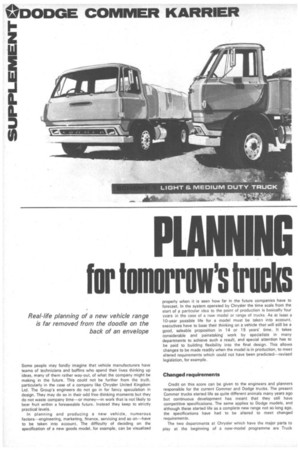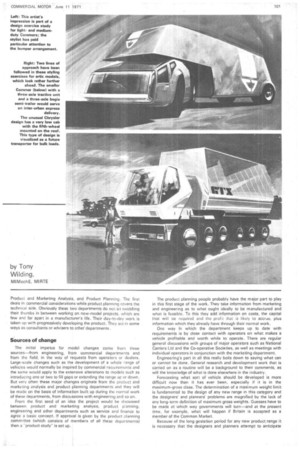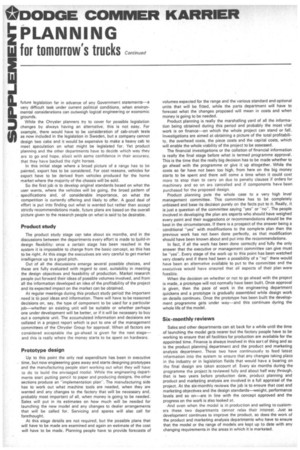PLANNING
Page 102

Page 103

Page 104

If you've noticed an error in this article please click here to report it so we can fix it.
for tomorrow's trucks
by Tony Wilding,
MIMechE, MIRTE
Real-life planning of a new vehicle range is far removed from the doodle on the back of an envelope
Some people may fondly imagine that vehicle manufacturers have teams of technicians and boffins who spend their lives thinking up ideas, many of them rather way-out, of what the company might be making, in the future. This could not be further from the truth, particularly in the case of a company like Chrysler United Kingdom Ltd. The Group's engineers do not go in for fancy speculation in design. They may do so in their odd free-thinking moments but they do not waste company time—or money—in work that is not likely to bear fruit within a foreseeable future. Instead they keep to strictly practical levels.
In planning and producing a new vehicle, numerous factors—engineering, marketing, finance, servicing and so on—have to be taken into account. The difficulty of deciding on the specification of a new goods model, for example, can be visualized properly when it is seen how far in the future companies have to forecast. In the system operated by Chrysler the time scale from the start of a particular idea to the point of production is basically four years in the case of a new model or range of trucks. As at least a 10-year possible life for a model must be taken into account, executives have to base their thinking on a vehicle that will still be a good, saleable proposition in 14 or 15 years' time. It takes considerable and painstaking work by specialists in many departments to achieve such a result, and special attention has to be paid to building flexibility into the final design. This allows changes to be made readily when the model is in production, to meet altered requirements which could not have been predicted—revised legislation, for exarnple.
Changed requirements
Credit on this score can be given to the engineers and planners responsible for the current Commer and Dodge trucks. The present Commer trucks started life as quite different animals many years ago but continuous development has meant that they still have competitive specifications. The same applies to Dodge models, and although these started life as a complete new range not so long ago, the specifications have had to be altered to meet changed requirements.
The two departments at Chrysler which have the major parts to play at the beginning of a new-model programme are Truck Product and Marketing Analysis, and Product Planning. The first deals in commercial considerations while product planning covers the technical side. Obviously these two departments do not sit twiddling their thumbs in between working on new-model projects, which are few and far apart in a manufacturer's life. Their day-to-day work is taken up with progressively developing the product. They act in some • ways as consultants or advisers to othei departments.
Sources of change
The initial impetus for model changes come from three sources—from engineering, from commercial departments and from the field, in the way of requests from operators or dealers. Large-scale changes such as the development of a whole range of vehicles would normally be inspired by commercial requirements and the same would apply to the extensive alterations to models such as introducing one or two to fill gaps or extending the range up or down. But very often these major changes originate from the product and marketing analysis and product planning departments and they will be made on the basis of information built up during the normal work of these departments, from discussions with engineering and so on.
From the first seed of an idea the project would be discussed between product and marketing analysis, product planning, • engineering and other departments such as service and finance to agree a basic concept. If approval is given by the product planning committee (which consists of members of all these departments} then a -product study" is set up.
The product planning people probably have the major part to play in this first stage of the work. They take information from marketing and engineering as to what ought ideally to be manufactured and what is feasible. To this they add information on costs, the capital that will be required and the profit that is likely to accrue, plus information which they already have through their normal work.
One way in which the department keeps up to date with requirements is by close contact with operators on what makes a vehicle profitable and worth while to operate. There are regular general discussions with groups of major operators such as National Carriers Ltd and the Co-operative Societies, as well as meetings with individual operators in conjunction with the marketing department.
Engineering's part in all this really boils down to saying what can or cannot be done. General research and development work that is carried on as a routine will be a background to their comments, as will the knowledge of what is done elsewhere in the industry.
Forecasting what sort of vehicle should be developed is more difficult now than it has ever been, especially if it is in the maximum-gross class. The determination of a maximum weight limit is fundamental to the design of any new range in this category and the designers' and planners' problems are magnified by the lack of any long-term definition of maximum gross weights. Guesses have to be made at Which way governments will turn—and at the present time, for example, what will happen if Britain is accepted as a member of the Common Market.
Because of the long gestation period for any new product, range it is necessary that the designers and planners attempt to anticipate
DE future legislation far in advance of any Government statements—a :11Lvery difficult task under current political conditions, when environmental considerations can outweigh logical engineering or economic grounds. While the Chrysler planners try to cover for possible legislation changes by always having an alternative, this is not easy. For inexample, there would have to be consideration of cab-crush tests as now included in the legislation in Sweden, but a company cannot design two cabs and it would be expensive to make a heavy cab to meet speculation on what might be legislated for. Yet product planning and the other departments have to decide which way they are to go and hope, albeit with some confidence in their accuracy, that they have backed the right horses.
In this initial stage where a broad picture of a range has to be painted, export has to be considered. For cost reasons, vehicles for export have to be derived from vehicles produced for the home market where the majority of the chassis will be sold.
So the first job is to develop original standards based on what the user wants, where the vehicles will be going, the broad pattern of specifications and, of considerable importance, on what the competition is currently offering and likely to offer. A good deal of effort is put into finding out what is wanted but rather than accept strictly recommendations made, future plans are based on the overall picture given to the research people on what is said to be desirable.
Product study
The product study stage can take about six months, and in the discussions between the departments every effort is made to build-in design flexibility: once a certain stage has been reached in the system it is impossible to change from the basic concept, so this has to be right. At this stage the executives are very careful to get market intelligence up to a good pitch.
Out of all the discussions emerge several possible choices, and these are fully evaluated with regard to cost, suitability in meeting the design objectives and feasibility of production. Market research people put forward their ideas of possible volumes involved, and from all the information developed an idea of the profitability of the project and its expected impact on the market can be obtained.
At regular meetings during this product study period the important need is to pool ideas and information. There will have to be reasoned decisions on, say, the type of component to be used for a particular job—whether an existing unit will be suitable or whether perhaps one under development will be better, or if it will be necessary to buy out a complete unit. The accumulated information and decisions are collated in a project report which is put to one of the management committees of the Chrysler Group for approval. When all factors are considered acceptable the go-ahead is given for the next stage— and this is really where the money starts to be spent on hardware.
Prototype design
Up to this point the only real expenditure has been in executive time, but now engineering goes away and starts designing prototypes and the manufacturing people start working out what they will have to do to build the envisaged model. While the engineering departments start putting pencil to paper and producing designs, the other sections produce an "implementation plan". The manufacturing side has to work out what machine tools are needed, when they are wanted and any changes to the factory that will be necessary and, probably most important of all, when money is going to be needed. Sales will put in its estimates on how much will be needed for launching the new model and any changes to dealer arrangements that will be called for. Servicing and spares will also call for forethought.
At this stage details are not required, but the possible plans that will have to be made are examined and again an estimate of the cost will have to be made. Planning people have to provide forecasts of
volumes expected for the range and the various standard and optional units that will be fitted, while the parts department will have to forecast what the changes proposed will mean in costs and when money is going to be needed.
Product planning is really the marshalling yard of all the information being obtained during this period and probably the most vital work is on finance—on which the whole project can stand or fall. Investigations are aimed at obtaining a picture of the total profitability, the overhead costs, the piece costs and the capital costs, which will enable the whole viability of the project to be assessed.
The financial investigations or the collation of financial information is really the final stage before what is termed programme approval. This is the time that the really big decision has to be made whether to go ahead with the programme or give it up altogether. While the costs so far have not been too high, from here on the big money starts to be spent and there will come a time when it could cost more to stop than to carry on due to penalty clauses if orders for machinery and so on are cancelled and if components have been purchased for the proposed design.
Product planning puts the whole case to a very high level management committee. This committee has to be completely unbiased and base its decision purely on the facts put to it. Really, it is just a question of the committee saying "yes" or "no". The people involved in developing the plan are experts who should have weighed every point and their suggestions or recommendations should be the best in the circumstances. If there is a prospect of the answer being a cOnditional "yes" with modifications to the complete plan then the previous work has not been done perfectly, as that modification should have been known about and put into the recommendations.
In fact, if all the work has been done correctly and fully the only answer that the executive or management committee can give must be "yes". Every stage of the work up to this point has been watched very closely and if there had been a possibility of a "no" there would have been an alternative available to put to the committee and the executives would have ensured that all aspects of their plan were feasible.
When the decision on whether or not to go ahead with the project is made, a prototype will not normally have been built. Once approval is given, then the pace of work in the engineering department quickens and a prototype is gradually assembled while design work on details continues. Once the prototype has been built the development programme gets under way—and this continues during the whole life of the model.
Six-monthly reviews
Sales and other departments can sit. back for a while until the time of launching the model gets nearer but the factory people have to be working to ensure that all facilities for production are available for the appointed time. Finance is always involved in this sort of thing and so is the product planning department and the product and marketing analysis department. These two have continuously to feed latest information into the system to ensure that any changes taking place in the industry or in legislation fields that would have a bearing on the final design are taken account of. Every six months during the programme the project is reviewed fully and about half way through, that is two years before production date, product planning and product and marketing analysis are involved in a full appraisal of the project. At the six-monthly reviews the job is to ensure that cost and marketing objectives and the design standards—weight, performance levels and so on—are in line with the concept approved and the progress on the work is also looked at.
.And even when the model is in production and selling to customers these two departments cannot relax their interest. Just as development continues to improve the product, so does the work of the product and marketing analysis departments who have to ensure that the model or the range of models are kept up to date with any changing requirements in the areas in which it is marketed.


































































































































































